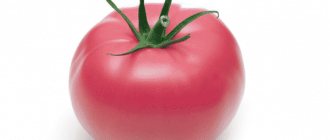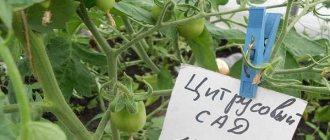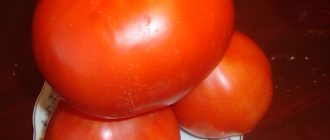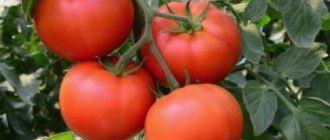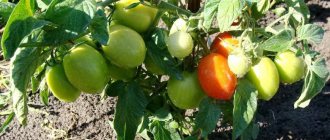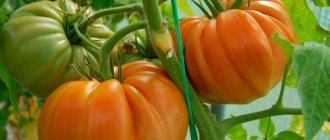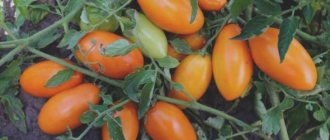Tomato variety "Children's" bears heavy bunches with delicious tiny cherry tomatoes. It is easy to grow, does not require much time or labor, and the yields are abundant and stable.
| Height | Landing location | Ripening time | Fruit color | Fruit size | Origin | Fruit shape |
| short | Greenhouse, Open ground | Early ripening | Reds | Small | Variety | Round |
Description of the variety
The distinctive features of this variety are:
- early ripeness;
- short stature, which allows it to be grown on balconies and small garden plots without damaging the space and the rest of the seedlings;
- Tomato variety “Children’s” does not require pinching;
- small leaf;
- bright saturated green color;
- simple inflorescence – classic;
- on one brush, despite its small size, up to 10 tomatoes are collected;
- fruits are oval-elongated;
- smooth to the touch with a slight gloss;
- reaches biological ripeness when painted bright red;
- fruit weight varies from 20 to 30 grams.
Rules for growing the variety
Gardeners should understand that caring for short-growing tomatoes of the Detsky variety will require taking into account certain nuances. Despite the fact that pinching and gartering lose their important meaning, control over the formation of the stem and regular care are still mandatory.
Experienced farmers note that it is still advisable to tie up tomatoes. In this case, the bush becomes more open to natural sunlight and is protected from parasites. As a result, staking tomato bushes increases the chances of successfully obtaining the desired result.
Low-growing tomato bushes do not always produce stepsons or form them in small quantities. In some situations, pinching is required, since this procedure is aimed at normalizing the load of the plant. Otherwise, there is a threat of partial loss of the tomato harvest.
Even low-growing tomatoes require proper and comprehensive care. So, what should you pay special attention to?
- Loosening the soil is mandatory. The condition of the soil determines the successful growth of tomatoes. For this reason, it is recommended to loosen the soil to obtain the optimal amount of oxygen and the proper development of the root system of vegetables. In addition, loosening the soil involves removing unwanted weeds.
- Fertilizer application is another important task. The use of properly selected nutrient mixtures improves the growth and development of tomatoes. In addition, regular fertilizing contributes to obtaining a large and high-quality harvest. However, abundant fertilization with nitrogen or organic matter is undesirable, since the plant will stretch out, the emphasis will be on the green mass and difficulties will arise in obtaining high-quality ripe tomatoes.
- Regular moderate watering is mandatory. It is advisable to use warm, settled water for watering tomatoes.
Such comprehensive care is always aimed at obtaining a high-quality harvest.
Planting and growing
The undoubted advantage of the “Children’s” tomato variety is that planting can be done at any convenient time of the year. IMPORTANT! Under no circumstances should you immediately immerse the seeds of your purchase in pots - this increases the risk of spreading diseases that could be on the seeds, and also reduces the number of seedlings (as a rule, about 10% of the seeds in the package are empty and are not able to germinate). Therefore, the seeds need to be prepared. For this:
- Place a spoonful of salt in a glass of water and stir thoroughly;
- Immerse the seeds in the solution and leave for 30 minutes;
- After time has passed, get rid of those that have surfaced - they are the ones that are not suitable for growing.
Then scatter the seeds on a plate and cover with a damp cloth. Leave them for three days BUT be sure to keep an eye on the humidity. Moisten the fabric as it dries.
After a few days, green sprouts will appear on the seeds and this is a signal for replanting. There is no point in replanting before.
Purchase soil and soil from a trusted gardening store. Do not use soil from your garden or street.
Now place the seeds to a depth of no more than 1 cm. The distance between the seedlings should be 2-3 cm. Cover the pots with transparent film (it can also be purchased at a specialty store). Keep under the film until the first leaves appear.
NECESSARILY! The temperature must be maintained:
- at night +17 degrees;
- during the daytime + 25 degrees.
Also take care of lighting, especially in winter, when daylight hours are significantly reduced.
After 3 weeks, the seedlings can be fed with fertilizers (choose those with the highest content of potassium and manganese. For example, Aelita - Vegetable).
After a month, the seedlings can be transplanted into full-sized pots. As a rule, this must be done after picking the third sheet. If you plan to plant in boxes, then keep a distance of 25-30 cm between the bushes.
Agricultural technology
For seedlings, tomato seeds are sown 50 - 55 days before the intended transplantation to a permanent place. In central Russia, the right time for sowing is the second half of March. In warm regions, you can sow a week to a week and a half earlier, in cold regions - a little later. Children's seedlings are grown in the usual way, following standard recommendations. By the time of transplantation, the plants need to be hardened off. In cool regions, seedlings are planted under film before the onset of favorable weather conditions. Caring for low-growing tomatoes is very easy, because the variety does not require gartering or pinching.
If you decide to experiment with growing tomatoes on the balcony, then success will not be achieved without knowing some of the nuances. After the seedlings have sprouted, they should be moved to a cooler, but bright enough room to avoid the sprouts from stretching. Picking is mandatory. Sufficient lighting is the main factor for a bountiful harvest. Therefore, place the growing bush in the brightest window. If there is not enough light in winter, then you cannot do without additional lighting. You should also monitor the temperature in the room - at night not lower than 15 °C, during the day - not higher than 27 °C. Watering is carried out with warm water; do not get too carried away with fertilizers. You can find out more about growing tomatoes on a windowsill in one of our articles.
Children's is a good way to please your household with early tomatoes grown literally on the windowsill. Of course, at home you will have to make some efforts to get a decent harvest. But this is a very interesting process, taking part in the transformation of a tiny seed into a tomato bush. This process will be especially exciting for children. It is easier to grow the variety in the garden, and care will not burden you with any special troubles.
Resistance to diseases and adverse conditions
As noted earlier, the “Children’s” tomato variety is resistant to late blight due to the speed of ripening and the abundance of the harvest, and also does not suffer from blossom-end and root rot.
As practice shows, tomatoes grown at home most often suffer from Fusarium wilt. The disease belongs to the genus of fungi and occurs due to high humidity. As soon as you start to notice that the following appear on the bush:
- yellowish tint of leaves;
- their twisting and lightening of the veins;
- rapid death of the lower leaves;
we can safely talk about the development of the disease. As a preventative measure, it is necessary to ventilate the room and loosen the soil as often as possible, and also ensure that the soil is not over-moistened. If the bush is affected, it is necessary to remove the bush and get rid of the soil. Fungi spread so quickly throughout the bush that even chemicals are unable to cope with them.
Unfavorable conditions that tomato does not tolerate well include:
- watering with cold water;
- excessive watering of the soil;
- non-compliance with the temperature regime (at night the temperature should not fall below +15 degrees, and during the day not below +20 degrees);
- draft (when ventilating the room, you need to remove the seedlings to another room or simply move them to the floor).
Reviews
Evgeniya:
“I really love growing Children’s variety tomatoes. Small and very tasty tomatoes always leave only the best impression. In addition, in order to get a good harvest, a minimum of time and effort is required. It is not surprising that even many beginners boldly choose the Children’s variety and try to grow it on their balconies. I’m very pleased with these tomatoes.”
Anna:
“Children’s is a very tasty and healthy variety of tomatoes. Correct agricultural technology and understanding of the main features of growing tomatoes guarantees the possibility of obtaining a decent harvest.”
Variety care
Water 2 times a week.
ATTENTION! You need to water strictly at the root. Under no circumstances should water get on the trunk or leaves. May lead to the development of fungal diseases. Don't pour too much water. The water should only be at room temperature. It is unacceptable to water with cold water.
In the evening, turn on the lamp to reduce the ripening time of fruits.
Apply fertilizers every 10 days. Mineral ones are ideal (for example, 6 grams of superphosphate per 1 liter of water).
After fertilizing and watering, loosen or water the soil, this way you will form a strong root system and prevent the occurrence of fungal diseases.
Remove all damaged, dried and fallen leaves immediately.
To increase yield, shake the bushes.
In which regions are the “Children’s” tomato grown?
This variety can be grown in all regions, as it is intended for growing in pots at home. The main condition is compliance with light and temperature conditions.
Application
This tomato is often simply called “baby” or “sweet”, since its taste has a pronounced sweetness, compared to other early-ripening varieties. In addition, the fruits contain many vitamins and microelements that are beneficial to the body. Tomatoes begin to ripen early, so they are most often used fresh in vegetable salads.
Related article:
Feeding tomatoes with folk remedies
However, the variety is also suitable for preparing preparations. Its fruits are juicy and are used to make juices, purees and pastes. At the same time, tomatoes are characterized by their small size and have a dense skin, so they are used for whole-fruit canning.
Simple gardening: High beds according to Kurdyumov
Features of cultivation and storage
They are planted traditionally - through seedlings.
Sowing of seeds begins at the end of February, the first half of March.
Planted in loose fertile soil, which is made up of:
- turf;
- compost;
- sand;
- peat
For disinfection, use 1% potassium permanganate or boiling water.
How to grow:
- The boxes are covered with film and kept warm until germination;
- hardened for 1 week at 14 degrees;
- maintain a temperature of 20-22 degrees;
- feed with “Krepysh” once every 10-12 days.
Features of care
Cultivation is carried out using the seedling method. Planting time is determined depending on the climatic conditions of a particular region and the desired harvest period. The recommended period for sowing planting material is the beginning of April.
The soil in the place of permanent cultivation should be fertile and well loosened. Before planting, it is recommended to treat the soil with a weak solution of potassium permanganate, which will reduce the risk of plant infection in the future. Carrots, zucchini, cauliflower crops, and herbs in the form of dill or parsley are considered good predecessors.
The seedlings are planted in accordance with the planting pattern of 50 by 40 cm. There should be from 7 to 9 tomato bushes per 1 m2. Care consists of timely watering, loosening the soil and removing weeds. During the growing season, it is necessary to fertilize tomato bushes with mineral complexes several times.
The best varieties of cherry tomatoes for greenhouse conditions
To grow cherry tomatoes in greenhouses, you need to pay attention to the following:
- height of tomato bushes;
- growth rate;
- type of branching of bushes.
All these nuances are important when growing vegetable plants indoors. At the same time, experts recommend planting hybrid tomatoes in greenhouses, although experienced vegetable growers prefer to grow only varietal tomatoes, from which they can collect seeds for further planting.
Important!
In order to obtain a harvest of cherry tomatoes in greenhouses throughout the summer and beyond - right up to the cold weather, it is recommended to plant semi-determinate and indeterminate tomatoes simultaneously.
Cherry tomato variety "Arctic"
This tomato is recommended for growing in greenhouse conditions and is distinguished by its ultra-early ripening of cherry tomatoes, which usually begin to be harvested 2.5 months after planting the seeds.
Photo of cherry tomato variety Arctic
Bushes are compact, determinate type, can reach 0.4 m in height
. The inflorescences are racemose, with up to 22-25 fruits ripening in each of them.
Cherry "White Muscat"
This tomato is one of the most productive among cherry tomatoes. However, good yields from White Muscat can only be achieved when grown in closed ground, and in garden beds in open ground - only in the south of Russia.
Indeterminate tomatoes grow well, reaching a height of 2.0-2.2 m
. Such tall shoots must be tied up; in greenhouse conditions, trellises are used for this. Plants need to be formed into no more than 3 shoots; this significantly increases the yield of the variety.
“White Muscat” cherry tomatoes are shaped like small pears, their weight is approximately 50 g, the color of ripe fruits is rich yellow, the taste is pleasant, quite sweet with a slight sourness.
Bing Cherry tomatoes
Vegetable growers rarely put up the fruits of this variety for sale - as gardeners themselves claim, this tomato is so tasty that its fruits are eaten very quickly.
The Bing Cherry tomato is indeterminate; its shoots in greenhouse conditions can reach 2.0 m, and outdoors - about 1.6 m. It is best to form Bing Cherry bushes into several shoots - up to 3 pieces. Fruiting can continue until the coldest weather.
Interesting article:
The best varieties of early peppers for open ground
The color of ripe fruits of this cherry variety is original; their color may contain the following colors:
- pink;
- red;
- lilac.
Ripe fruits can be quite large - more than 70 g.
Cherry tomato variety "Bull's eye"
This indeterminate tomato can be grown outdoors and in greenhouses; the height of well-leafed shoots can reach 1.8-2.0 m. The ripening period for spherical, red-colored cherry tomatoes is more than 3.5 months.
Photo of cherry variety Bull's Eye
Racemose inflorescences can contain from 12 to 40 tomatoes. The weight of ripened fruits is about 30 g. At the moment of friendly ripening of tomatoes, Bull's Eye bushes look very beautiful and will decorate beds not only in vegetable gardens, but also in greenhouse conditions.
Cherry tomatoes "Gardener's Delight"
This cherry tomato variety was bred by German breeders. The main characteristics of medium-height bushes: long fruiting period, average ripening time for spherical tomatoes weighing 35 g, up to 7-10 ovaries are formed in each racemose inflorescence. The color of the fruit is rich red.
The height of erect shoots is about 1.3 m. To increase the yield, no more than 3 shoots should be left on each bush.
Cherry "Thumbelina"
The fruits of this variety ripen quite early - after about three months. It is best to grow Thumbelina tomato in any type of greenhouse. The height of erect shoots can be up to 1.5 m. Vegetable growers should regularly remove emerging shoots and form bushes of no more than three shoots.
The clusters are quite long and can produce up to 14-16 tomatoes. The fruits are spherical in shape and bright red in color. Their weight does not exceed 20 g. From each square of cherry tomatoes of this variety, up to 5 kg of ripe products are collected per season.
Video about cherry Thumbelina
Cherry tomato variety "Cafe Boulet"
The Cafe Boulet variety is productive and early ripening - ripe fruits can be harvested approximately 90 days after the appearance of the first sprouts.
